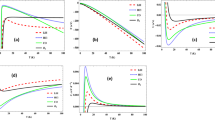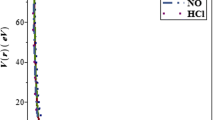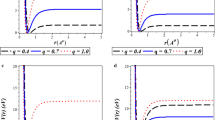Abstract
The analytical methods for solving Schrödinger equation are essential and effective tools with which we can investigate the spectroscopic properties, the electronic structure, and the energetic properties of the diatomic molecules (DMs). Accordingly, in this work, we used the Nikiforov-Uvarov (NU) method to solve the three-dimensional nonrelativistic Schrödinger equation with the molecular Kratzer-Feus (KF) potential and obtain the exact analytical bound state energy eigenvalues as well as their corresponding normalized eigenfunctions. The effective KF diatomic molecular potential well is investigated and represented graphically for several well-known DMs. The bound state energy levels are tabulated numerically for arbitrary values of the vibrational and rotational quantum numbers. The results obtained in this work are found to be in excellent agreement with the already-existing results in the literature.
Similar content being viewed by others
1 Introduction
One of the main objectives of quantum mechanics is to determine the exact analytical solutions of Schrödinger equation with a given potential for the quantum mechanical system. This is due to the fact that the complete wave function involves implicitly all the required information to completely define the observable quantities of the quantum system under consideration; furthermore, a thorough analysis of the diatomic molecular spectroscopy has been traced back to the bound state energy spectra of the atomic and molecular systems under investigation.
The KF potential, is defined as follows [1, 2]:
where \({D}_{o}\) is the bond interaction dissociation energy between two atoms in the DM separated by an equilibrium internuclear distance \({r}_{e}\). This potential is a superposition of the well-known attractive Coulomb potential at large distances and a repulsive centrifugal potential barrier at short distances. Their combination generates an effective potential well, which serves as a potential model to investigate the molecular structure, the molecular energy spectra, the chemical interactions, and the internuclear vibration [3, 4] of the diatomic molecules. This potential belongs to the class of the diatomic molecular potentials [5] for its ability to specify the range of attraction and the strength of the repulsive interactions.
Different methods have been used to study diatomic energy spectra using diatomic molecular potentials: the NU method [6,7,8,9,10,11,12], the exact method [13], the shifted 1/N expansion [14], the exact quantization rule method [15], the SUSY approach [16], the tridiagonal J-matrix representation [17, 18], and algebraic methods [19, 20].
Z.Yalçin et al. [21] have obtained the eigen-energies of the excited 1 and 3 S states of the He atom with the molecular KF potential by using the hyper-spherical harmonics method. Furthermore, they have demonstrated that the KF potential well is sharper and deeper than the pure Coulombic potential well. Also, E. Ikhdair et al. [22] have determined the exact solutions of the D-dimensional Schrödinger equation with the KF potential by means of the standard method. Moreover, Shi-hai Dong and Gus-hua Sun [23] have obtained the exact analytical solutions of the radial Schrödinger equation with the KF potential in D dimensions. In addition, they have studied the dependence of the energy eigenvalues on the spatial dimension D. The KF potential has been extensively investigated by means of the factorization method [24], the asymptotic iteration method [25], among other analytical methods.
The aim of the present work is to take a different approach and solve Schrödinger equation analytically with the KF potential by using the NU method and to obtain the bound state energy levels for the homonuclear and heteronuclear diatomic molecules N2, H2, O2, NO, HCl, CH and LiH.
This work is organized as follows: The NU method is introduced briefly in Sect. 2. In Sect. 3, the exact eigenvalues are obtained and their corresponding radial eigenfunctions are analytically formulated by solving the radial Schrödinger equation within the context of the NU method for KF potential. In Sect. 4, we performed numerical calculations of the rovibrational energy levels for the above-mentioned DMs. Also, a graphical representation and discussion of the effective potential well are given. Finally, our work is concluded in Sect. 5 with a summary and concluding remarks.
2 The Nikiforov-Uvarov Method
The NU method [26, 27] is dedicated to solving the hypergeometric type equations of the form:
where \(\tilde{\tau }\left(x\right)\) is a polynomial of degree at most one, \(\sigma \left(x\right)\) and \(\tilde{\sigma }\left(x\right)\) are polynomials of degree at most two, \(\psi \left(x\right)\) is a hypergeometric-type function, via orthogonal polynomials. Furthermore, the function \(\psi \left(x\right)\) takes the form:
Equation (2) can be reformulated to a hypergeometric type of equation of the form:
to obtain its solutions. We introduce the following function of a maximum first degree:
The maximum first degree of \(\pi \left(x\right)\) imposes a restriction on the expression under the radical, its discriminant must be equal to zero. Equating the discriminant to zero yields a quadratic equation for \(k\), which can be solved algebraically to get the possible values of \(k\) and the corresponding values of \(\pi \left(x\right)\). It is worth noting that, according to the method, we must select the values of \(\pi \left(x\right)\) for which \({\tau }^{{\prime }}\left(x\right)<0\).
The hypergeometric type of function \(Y\left(x\right)\) in Eq. (3) is obtained by Rodrigus formula:
where \({B}_{n}\) is the normalization constant, \(\rho \left(x\right)\) is the weight function satisfying the conditions:
According to the NU method, the parameter \(\lambda\) is defined by:
Accordingly, the eigenvalues, Eq. (4), can be obtained from the following equation:
It is worth noting that \(\lambda\) and \({\lambda }_{n}\) are obtained from a particular result of \({Y\left(x\right)=Y}_{n}\left(x\right).\) The function \(\varphi \left(x\right)\), in Eq. (3), is obtained from the following logarithmic derivative:
3 Bound state eigenvalues and their corresponding Radial Eigenfunctions for the KF potential by means of NU Method
The radial equation for KF potential is of the form:
where \(\mu\) is the reduced mass, \(l\) is the orbital angular momentum quantum number, and \(n\) is the vibrational quantum number. Introducing the following parameters:
the radial equation can be expressed as
Comparing Eq. (14) with Eq. (2), we obtain the following:
Hence, by means of Eq. (5) we can write \(\pi \left(r\right)\) as follows:
To determine the constant \(k\), the discriminant must be equal to zero, and as a result we obtain
Inserting Eq. (17) into Eq. (16), \(\pi \left(r\right)\) can be rewritten as
Accordingly, we select a particular expression for \(\pi \left(r\right)\) which meets the condition \({\tau }^{{\prime }}\left(r\right)<0\) as
From Eq. (8), \(\tau \left(r\right)\) is given by:
From Eq. (9) and Eq. (10), the parameters \(\lambda\) and \({\lambda }_{n}\) are given by:
Equating the two equations above, we obtain
Substituting for the values of the parameters \(\alpha\), \(\gamma\), and\(\omega\) we get the bound state eigenvalues in the form:
Equation (24) is identical to the energy eigenvalue equation provided by Eq. (28) of Ref. [28], if we take the substitution \(N=3\). Hence, we finally obtain the energy eigenvalue equation:
To determine the normalized radial eigenfunctions \({R}_{nl}\) in terms of the orthogonal associated Laguerre polynomials, consider Eq. (11) from which we can recast the logarithmic derivative as follows
Inserting the expressions for \(\pi \left(r\right)\) and \(\sigma \left(r\right)\) into the above equation we yield
Applying the same logarithmic derivative transformation to Eq. (7) yields
from which we get
By means of Eq. (6), \({Y}_{n}\left(r\right)\) is given by
which can be compared to the well-known Rodrigues formula for the orthogonal associated Laguerre polynomials [29]
by taking \({B}_{n}= \frac{1}{n!}\), \(k=\gamma\), \(\xi =\delta r\). Hence, we obtain:
Finally, from Eqs. (27) and (32) the normalized radial eigenfunctions can be expressed in terms of the orthogonal Laguerre polynomials as follows
With the aid of the normalization condition
and the result of Ref. [29]
the normalization constant \({N}_{nl}\) takes the form:
Substituting Eq. (36) into Eq. (33), we finally get
4 Results and discussion
The energy levels for the diatomic molecules HCl, CH, N2, H2, O2, NO, and LiH are computed numerically and tabulated in Tables 1, 2, 3, 4 and 5, by means of spectroscopic parameters presented in Table 6. The eigenvalues obtained in Tables 1, 2, 3 and 4 are in excellent agreement with the values computed previously by means of alternative methods [25], [30,31,32], [34]. To the best of our knowledge, our work is the first to quantify the energy levels of N2, H2, and CH DMs in the context of the KF interaction. With the aim of providing a comparative benchmark against which future studies can be compared, we have only included our data for these DMs in Table 6.
In Fig. 1, the KF potential is plotted for several DMs; its graphical representation reveals the nature of the chemical bond and the molecular behavior at r = \({r}_{e}.\) As shown in Fig. 1, the potential becomes infinite as the internuclear separation approaches zero due to the internuclear repulsion. On the other hand, as the molecule decomposes, the internuclear separation tends to infinity, and consequently, the potential vanishes. According to Tables 1, 2, 3, 4 and 5, and Fig. 1, the eigenvalues of N2 are greater than those of the other diatomic molecules, since its potential depth is sharper and larger than the other ones. Therefore, we detect an increase in the energy eigenvalues as the molecular potential depth increases.
5 Conclusion
In the present paper, we solved Schrödinger equation for KF potential to get energy eigenvalues and the corresponding normalized total wavefunctions. Numerical results are represented for some well-known diatomic molecules. The findings of this work demonstrate the remarkable precision with which the KF potential models the diatomic molecular structures and quantifies their bound state energy levels. Our results can be extended into applications in future research studies.
Data Availability
All datasets and software used for supporting the conclusion of this article are available from our own software.
References
A. Kratzer, Z. für Phys 3, 289 (1920)
E. Fues, Ann. Phys. 80, 367 (1926)
F. Hoseini, J.K. Saho, H. Hassanabadi, Comm. Theor. Phys. 65, 695 (2016)
S.A. Najafizade, H. Hassanabadi, S. Zarrinkamar, Can. J. Phys. 94, 1085 (2016)
H.M. Hulburt, J.O. Hirschfelder, J. Chem. Phys 9, 61 (1941)
C. Berkdermir, J. Math. Chem. 46, 492 (2009)
C. Berkdermir, R. Server, J. Math. Chem. 46, 1122 (2009)
S.M. Ikhdair, Chem. Phys. 361, 9 (2009)
C. Berkdermir, J. Han, Chem. Phys. Lett. 409, 203 (2005)
R. Sever, C. Tezcan, Ö Akta¸s, Ye¸silta¸s, J. Math. Chem. 43, 845 (2007)
C. Berkdermir, A. Berkdemir, J. Han, Chem. Phys. Lett. 417, 326 (2006)
R. Sever, M. Bucurgat, C. Tezcan, Ö Yeşiltaş, J. Math. Chem. 43, 749 (2007)
S. Ikhdair, R. Sever, J. Mol. Struct. 806, 155 (2007)
D.A. Morales, Chem. Phys. Lett. 161, 253 (1989)
W.C. Qiang, S.H. Dong, Phys. Lett. A 363, 169 (2007)
D.A. Morales, Chem. Phys. Lett. 394, 68 (2004)
I. Nasser, M.S. Abdelmonem, H. Bahlouli, A.D. Alhaidari, J. Phys. B: At. Mol. Opt. Phys. 40, 4245 (2007)
I. Nasser, M.S. Abdelmonem, H. Bahlouli, A.D. Alhaidari, J. Phys. B: At. Mol. Opt. Phys. 41, 215001 (2008)
K.J. Oyewumi, Int. J. Theor. Phys. 49, 1302 (2010)
M. Badawi, N. Bessis, G. Bessis, J. Phys. B: Atom Mol. Phys. 5, L157 (1972)
M. Z.Yalçin, Aktaş, M. şimşek, Int. J. Quantum Chem. 76, 618 (2000)
S.M. Ikhdair, R. Sever, J. Mol. Struct. 855, 13 (2008)
S.H. Dong, G.H. Sun, Phys. Scr. 70, 94 (2004)
I.B. Okon, E.E. Ituen, O. Popoola, A.D. Antia, Int. J. Recent. Adv. Phys. 2, 1 (2013)
O. Bayrak, I. Boztosun, H. Çiftçi, Int. J. Quant. Chem. 107, 540 (2007)
A.F. Nikiforov, V.B. Uvarov, Special Functions of Mathematical Physics A UNIFIED INTRODUCTION with Applications (Birkhäuser, Boston, MA, 1988)
C. Berkdemir, Application of the Nikiforov-Uvarov Method in Quantum Mechanics, (InTech, UK, 2012)
K.J. Oyewumi, Found. Phys. Lett. 18, 75 (2005)
I. Gradshteyn, Solomonovich, and Iosif Moiseevich Ryzhik. Table of Integrals, Series, and Products (Academic press, UK, 2014)
S.M. Ikhdair, R. Sever, J. Math. Chem. 45, 1137 (2009)
A.N. Ikot et al., Eclet. Quim. 45, 65 (2020)
E.E. Ibekwe, U.S. Okorie, J.B. Emah, E.P. Inyang, S.A. Ekong, Eur. Phys. J. Plus 136, 1 (2021)
K.J. Oyewumi, K.D. Sen, J. Math. Chem. 50, 1039 (2012)
K.R. Purohit, R.H. Parmar, A.K. Rai, J. Mol. Model. 27, 1 (2021)
Acknowledgements
We are very grateful to the anonymous reviewers for their valuable suggestions.
Funding
This research is not funded.
Open access funding provided by The Science, Technology & Innovation Funding Authority (STDF) in cooperation with The Egyptian Knowledge Bank (EKB).
Author information
Authors and Affiliations
Contributions
All authors contribute equally.
Corresponding author
Ethics declarations
Competing interests
The authors declare that they have no competing interests.
Consent for publication
Agree.
Ethics approval and consent to participate
Agree.
Additional information
Publisher’s Note
Springer Nature remains neutral with regard to jurisdictional claims in published maps and institutional affiliations.
Rights and permissions
Open Access This article is licensed under a Creative Commons Attribution 4.0 International License, which permits use, sharing, adaptation, distribution and reproduction in any medium or format, as long as you give appropriate credit to the original author(s) and the source, provide a link to the Creative Commons licence, and indicate if changes were made. The images or other third party material in this article are included in the article's Creative Commons licence, unless indicated otherwise in a credit line to the material. If material is not included in the article's Creative Commons licence and your intended use is not permitted by statutory regulation or exceeds the permitted use, you will need to obtain permission directly from the copyright holder. To view a copy of this licence, visit http://creativecommons.org/licenses/by/4.0/.
About this article
Cite this article
Doma, S.B., Gohar, A.A. & Younes, M.S. Analytical Solutions of the Molecular Kratzer-Feus potential by means of the Nikiforov-Uvarov Method. J Math Chem 61, 1301–1312 (2023). https://doi.org/10.1007/s10910-023-01462-y
Received:
Accepted:
Published:
Issue Date:
DOI: https://doi.org/10.1007/s10910-023-01462-y





